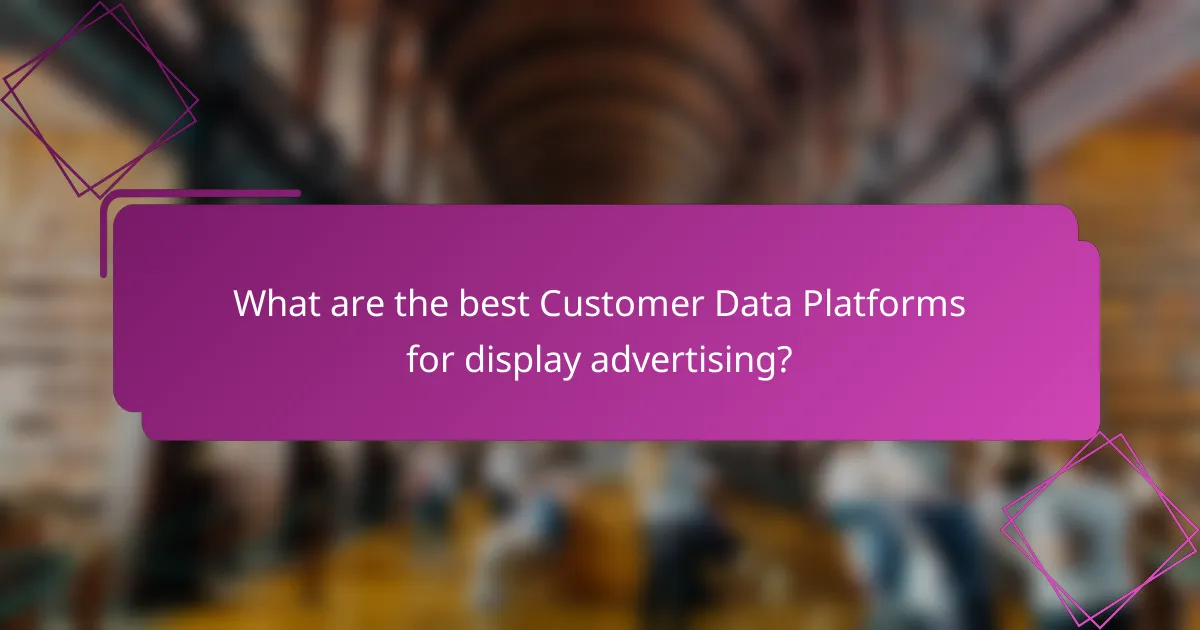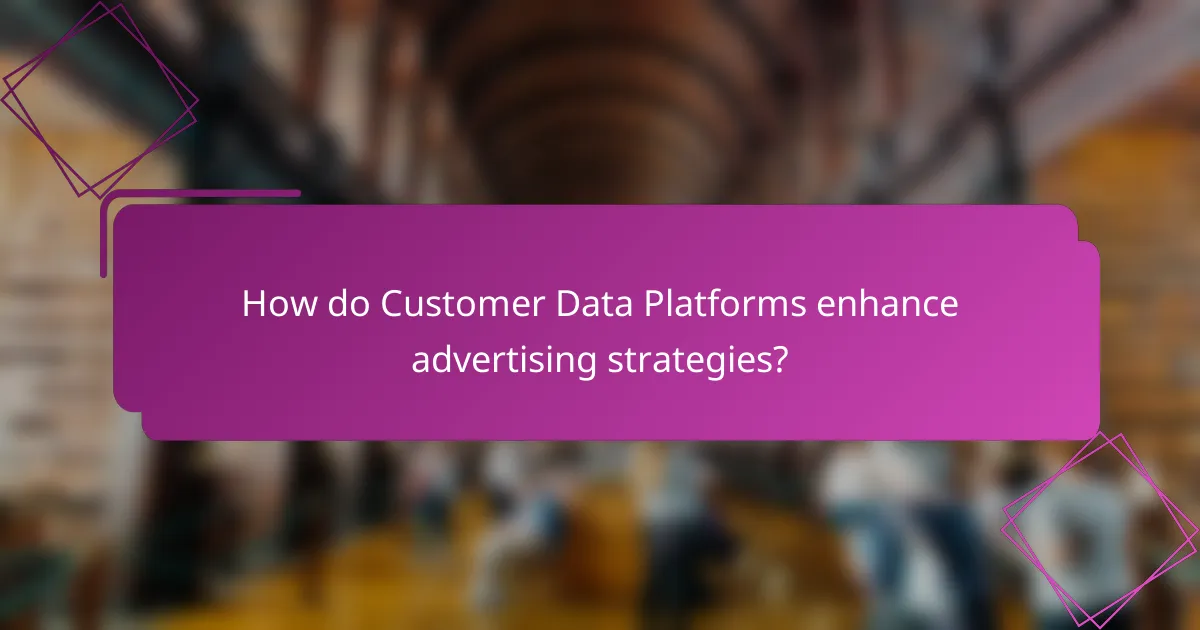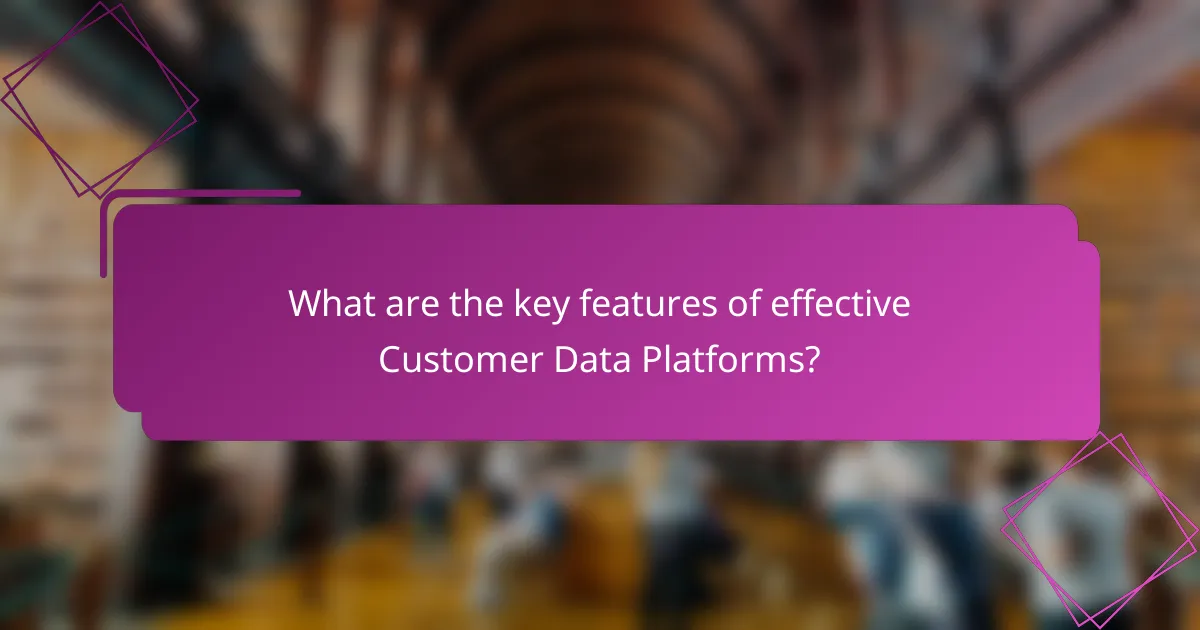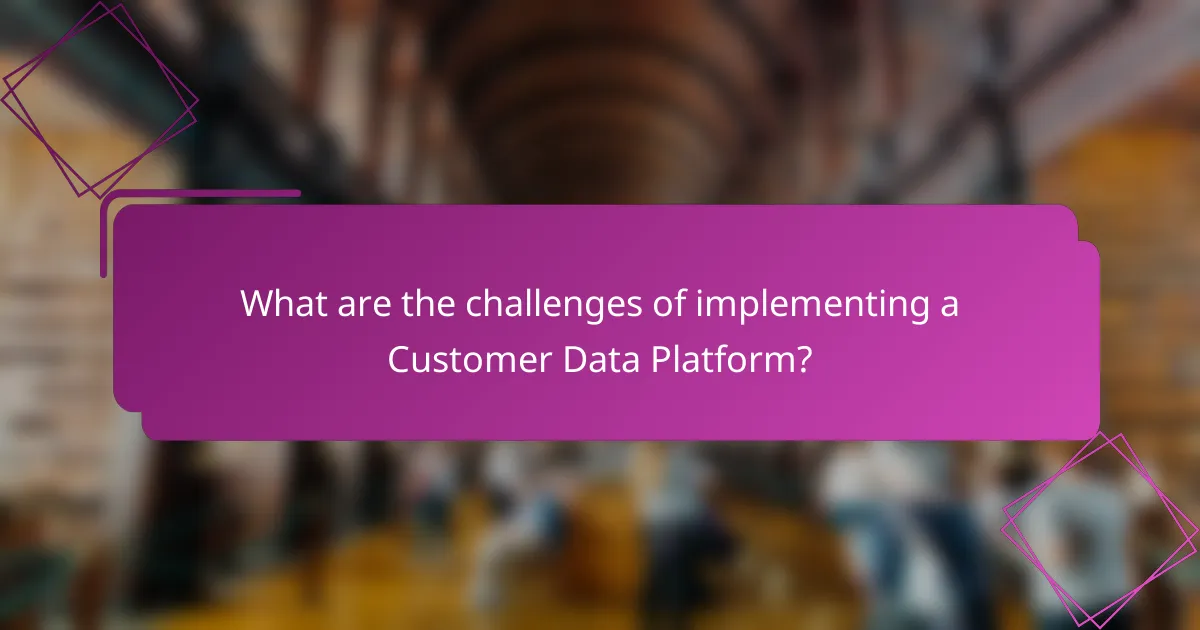Customer Data Platforms (CDPs) play a crucial role in modern marketing by consolidating data from multiple sources to form comprehensive customer profiles. This integration empowers businesses to execute targeted advertising campaigns, enhancing engagement and conversion rates through personalized marketing efforts. With features like advanced analytics and robust data segmentation, CDPs enable marketers to optimize their strategies effectively while ensuring compliance with privacy regulations.

What are the best Customer Data Platforms for display advertising?
The best Customer Data Platforms (CDPs) for display advertising integrate data from various sources to create comprehensive customer profiles, enabling targeted ad campaigns. Key players in this space offer robust features for data segmentation, audience analysis, and real-time integration, allowing marketers to optimize their advertising strategies effectively.
Segment
Segment is a leading CDP that focuses on data collection and integration from multiple sources. It allows businesses to unify customer data across various touchpoints, providing a single view of the customer. This capability is essential for display advertising, as it enables precise targeting based on user behavior and preferences.
With Segment, marketers can easily create audience segments for display campaigns, ensuring that ads reach the right people at the right time. The platform supports various integrations with advertising networks, facilitating seamless data flow for optimized ad performance.
BlueConic
BlueConic is a versatile CDP that emphasizes real-time customer engagement and personalization. It allows marketers to collect and analyze data from different channels, creating dynamic customer profiles that can be used for targeted display advertising. This platform is particularly useful for brands looking to enhance customer experiences through tailored messaging.
One of BlueConic’s strengths is its ability to integrate with various marketing tools, enabling marketers to activate data across their advertising efforts efficiently. This integration helps in crafting personalized display ads that resonate with specific audience segments.
Salesforce Customer 360
Salesforce Customer 360 is a comprehensive CDP that provides a holistic view of customer interactions across all channels. It leverages Salesforce’s vast ecosystem to gather and analyze data, making it a powerful tool for display advertising. Marketers can use insights from Customer 360 to create targeted campaigns that drive engagement and conversions.
This platform excels in its integration capabilities, allowing businesses to connect their advertising efforts with customer relationship management (CRM) data. This synergy enhances the effectiveness of display ads by ensuring they are aligned with customer needs and behaviors.
Tealium AudienceStream
Tealium AudienceStream is a robust CDP that focuses on real-time audience segmentation and data orchestration. It enables marketers to create detailed customer profiles by aggregating data from various sources, which is crucial for effective display advertising. With AudienceStream, businesses can quickly identify and target specific audience segments based on their behaviors and preferences.
The platform’s real-time capabilities allow for immediate adjustments to advertising strategies, ensuring that display ads are always relevant. Tealium also offers extensive integration options, making it easy to connect with other marketing technologies for a cohesive advertising approach.
Oracle CX Unity
Oracle CX Unity is a powerful CDP designed to unify customer data across different channels and touchpoints. It provides a comprehensive view of customer interactions, which is essential for crafting effective display advertising strategies. Marketers can leverage insights from CX Unity to create highly targeted campaigns that improve engagement and conversion rates.
Oracle CX Unity’s integration with Oracle’s suite of marketing tools enhances its capabilities, allowing for seamless execution of display ads based on unified customer insights. This integration ensures that advertising efforts are data-driven and aligned with overall marketing objectives.

How do Customer Data Platforms enhance advertising strategies?
Customer Data Platforms (CDPs) enhance advertising strategies by consolidating customer data into unified profiles, enabling businesses to deliver targeted and personalized marketing efforts. This integration of data allows for more effective advertising, leading to improved engagement and conversion rates.
Unified customer profiles
Unified customer profiles are central to the functionality of CDPs. By aggregating data from various sources—such as website interactions, social media, and purchase history—CDPs create comprehensive views of individual customers. This holistic understanding allows marketers to tailor their strategies based on specific customer behaviors and preferences.
For example, a retail brand can use a CDP to combine data from in-store purchases and online browsing, enabling them to identify loyal customers and target them with relevant offers. This approach enhances customer loyalty and increases the likelihood of repeat purchases.
Real-time data integration
Real-time data integration is a key feature of CDPs that significantly boosts advertising effectiveness. By continuously updating customer profiles with the latest interactions and transactions, businesses can respond promptly to customer needs and market trends. This agility is crucial in today’s fast-paced digital landscape.
For instance, if a customer abandons a shopping cart, a business can immediately trigger a follow-up email with a discount offer. This timely engagement can dramatically increase the chances of conversion, making real-time integration a powerful tool in advertising strategies.
Personalized marketing campaigns
Personalized marketing campaigns are made possible through the insights gained from unified customer profiles and real-time data. CDPs enable businesses to segment their audience based on detailed criteria, allowing for highly targeted messaging. This level of personalization can significantly enhance customer engagement.
For example, a travel company can create tailored email campaigns based on previous travel destinations and preferences, offering relevant deals to specific customer segments. This targeted approach often results in higher open and click-through rates compared to generic campaigns.
Improved customer insights
Improved customer insights are a direct benefit of utilizing a CDP. By analyzing the aggregated data, businesses can uncover trends and patterns that inform their advertising strategies. These insights help in understanding customer behavior, preferences, and potential future actions.
For instance, a business might discover that a significant portion of its customers prefers eco-friendly products. This insight can guide advertising efforts to highlight sustainable options, aligning marketing messages with customer values and increasing overall effectiveness.

What are the key features of effective Customer Data Platforms?
Effective Customer Data Platforms (CDPs) centralize customer data from various sources, enabling businesses to create a unified customer profile. Key features include robust data integration, advanced analytics, targeted segmentation, and compliance with privacy regulations.
Data integration capabilities
Data integration is crucial for a CDP, allowing it to consolidate information from multiple sources such as CRM systems, social media, and e-commerce platforms. Look for platforms that support various data formats and APIs to ensure seamless connectivity.
Effective CDPs often utilize ETL (Extract, Transform, Load) processes to clean and harmonize data. This ensures that the integrated data is accurate and ready for analysis, providing a single source of truth for customer insights.
Analytics and reporting tools
Analytics and reporting tools within a CDP help businesses derive actionable insights from customer data. These tools typically include dashboards that visualize key metrics, trends, and customer behaviors, enabling data-driven decision-making.
When selecting a CDP, consider platforms that offer customizable reporting options and predictive analytics capabilities. This allows businesses to forecast customer behaviors and tailor marketing strategies accordingly.
Segmentation and targeting options
Segmentation and targeting options are essential for personalizing customer interactions. A robust CDP enables users to create dynamic segments based on various criteria such as demographics, purchase history, and engagement levels.
Effective segmentation allows for more precise targeting in marketing campaigns, improving conversion rates. Look for CDPs that offer real-time updates to segments, ensuring that marketing efforts are based on the most current customer data.
Privacy compliance features
Privacy compliance features in a CDP are vital for adhering to regulations such as GDPR or CCPA. These features should include tools for data anonymization, consent management, and easy access for customers to manage their data preferences.
When evaluating a CDP, ensure it provides clear documentation on how it handles data privacy and security. This not only protects customer information but also builds trust with your audience, which is essential for long-term success.

What criteria should be considered when selecting a Customer Data Platform?
Selecting a Customer Data Platform (CDP) requires careful consideration of several key criteria to ensure it meets your business needs. Focus on scalability, integration capabilities, cost-effectiveness, and user experience to make an informed choice.
Scalability
Scalability is crucial for a Customer Data Platform, as it determines how well the system can grow with your business. Look for platforms that can handle increasing volumes of data and users without compromising performance.
Consider options that offer flexible pricing models based on usage, allowing you to scale up or down as needed. This adaptability can save costs in the long run while ensuring your CDP remains effective as your data needs evolve.
Integration with existing tools
Effective integration with your current tools is essential for a seamless data flow. Ensure the CDP can connect with your existing marketing, sales, and analytics platforms to centralize customer data efficiently.
Check for pre-built connectors or APIs that facilitate integration. A platform that easily integrates with tools like CRM systems or email marketing software can enhance your operational efficiency and data accuracy.
Cost-effectiveness
Cost-effectiveness is a vital consideration when selecting a Customer Data Platform. Evaluate not just the upfront costs but also ongoing expenses related to maintenance, support, and upgrades.
Compare pricing models, such as subscription-based versus pay-as-you-go, to find the best fit for your budget. Aim for a solution that provides a good balance between features and affordability, ensuring you get value for your investment.
User-friendly interface
A user-friendly interface is important for ensuring that your team can effectively utilize the Customer Data Platform. Look for platforms that prioritize intuitive design and ease of navigation to minimize the learning curve.
Consider platforms that offer robust training resources and customer support, which can enhance user adoption and satisfaction. A well-designed interface can significantly improve productivity and reduce the time spent on data management tasks.

What are the challenges of implementing a Customer Data Platform?
Implementing a Customer Data Platform (CDP) presents several challenges, including data privacy concerns and integration complexities. Organizations must navigate these issues to effectively harness customer data while ensuring compliance and operational efficiency.
Data privacy concerns
Data privacy is a significant challenge when implementing a CDP, especially with regulations like GDPR in Europe and CCPA in California. Companies must ensure that they collect, store, and process customer data in compliance with these laws to avoid hefty fines and reputational damage.
To address privacy concerns, organizations should establish clear data governance policies. This includes obtaining explicit consent from customers, implementing robust security measures, and regularly auditing data practices to ensure compliance with evolving regulations.
Integration complexities
Integrating a CDP with existing systems can be complex due to disparate data sources and varying formats. Organizations often struggle to unify data from CRM systems, marketing platforms, and e-commerce sites, which can lead to incomplete customer profiles.
To simplify integration, businesses should prioritize selecting a CDP that offers pre-built connectors for popular platforms. Additionally, investing in data mapping and transformation tools can help streamline the process, ensuring a smoother transition and more accurate data consolidation.
